Video Borescoping Technology Adds New Dimension to Scale Control

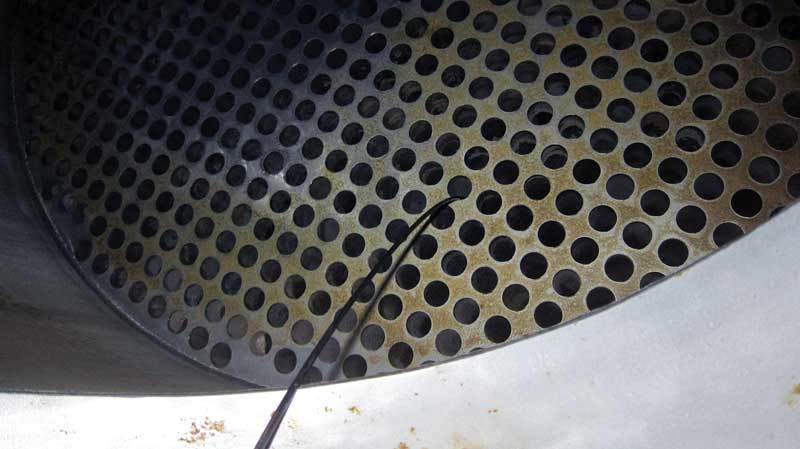
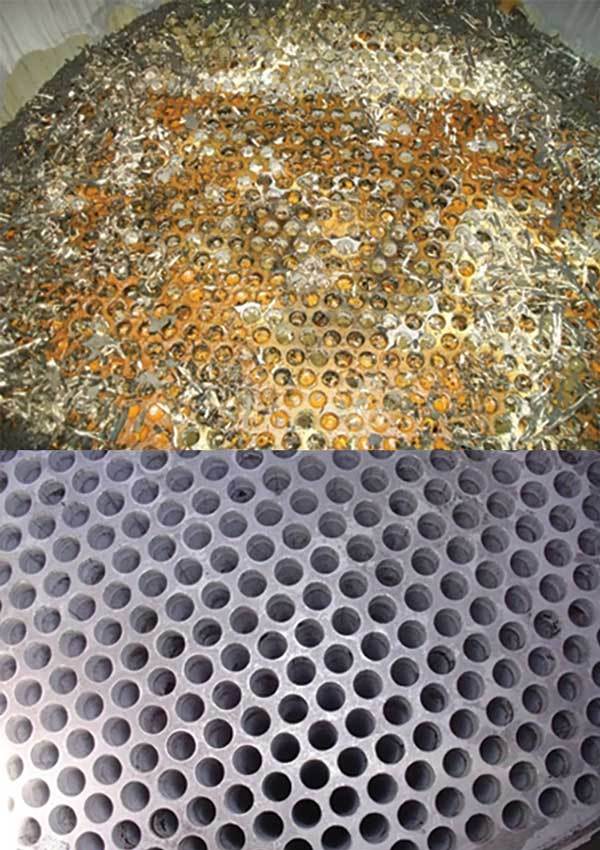
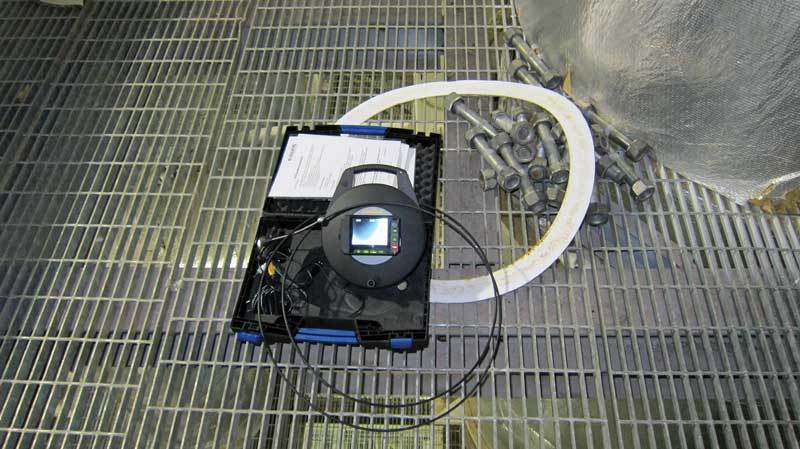
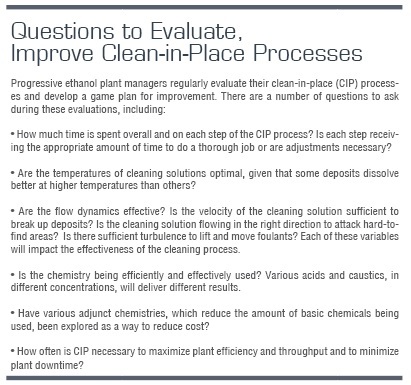
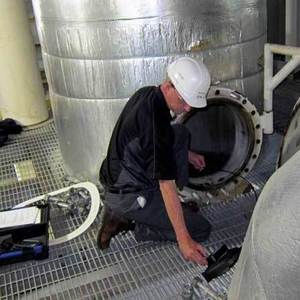
PHOTO: SOLENIS
June 9, 2016
BY Andrew Ledlie
Evaporators, which consume a tremendous amount of energy to drive off water and increase the solids levels in the syrup, are critical to the operation of an ethanol plant. Given their importance to the ethanol production process and the plant’s bottom line, plant managers invest substantial time and money to clean the evaporators and ensure that they are operating at peak capacity and efficiency. Among the traditional tools in their arsenals are hydroblasting, scale inhibitors, clean-in-place (CIP) programs or pH control to address scale issues.
However, plant managers often have questioned the efficacy of hydroblasting and other measures to maximize the cleanliness of the evaporators. The answers to their questions are becoming much clearer with the use of video borescopes to evaluate the interiors of evaporators.
A video borescope is an optical device consisting of a flexible tube with a video screen on one end and a high-definition camera and light on the other. Using the tube, the camera and light can be fed deep into inaccessible areas, making it possible to capture video or still images. Video borescoping technology is used in applications ranging from sewer repairs to chiller inspections to medical surgeries.
Video borescoping technology, so far, has been applied only sparingly in ethanol plants, but that is beginning to change. Solenis, for example, has been providing this service to fuel ethanol plants as a way to demonstrate the effectiveness of its Polystabil scale inhibitors and to evaluate the plant’s other scale control initiatives.
Ethanol plant managers also are taking advantage of borescoping technology to assess the efficacy of hydroblasting when the evaporators are opened for routine maintenance. For example, after two days of hydroblasting evaporators at an ethanol plant in Indiana, a visual evaluation determined that the tubes were clean. However, when a borescope was lowered into the tubes, significant scale buildup was found at a depth of 8 feet requiring additional hydroblasting to rectify the situation.
Maximizing Borescoping
The value of video borescoping can be maximized with thorough preparation and planning. Plant managers who institute a borescoping program get the best results when they implement a plan.
Plant managers, for example, should keep organized records of when shutdowns occur, the condition of each evaporator and the amount of time spent hydroblasting, as well as any process changes designed to prevent scale formation. Managers should hire a professional who has experience with video borescope inspections, using a high-quality borescope that produces high-definition images and is long enough to scope the tube’s length. Another important part of the planning process is to coordinate the timing of the video borescoping with the company performing the hydroblasting, ensuring the borescoping technician has access to the evaporators when they are cool enough for the scope to take clear images without fogging up.
Meanwhile, plant managers should build time into the schedule to reblast any trouble spots identified during the borescoping and should ensure that the video borescope technician understands required safety procedures and employees’ standards. The standards must be in line with the standards of the plant and the hydroblasting team. Safety considerations include high temperatures and steam when the evaporators are opened and the need for a permit if the borescope technician has to enter a confined space to conduct the inspection.
Another key to successful borescoping is being in agreement with the borescope technician on the format of the report and where videos can be archived for easy access during the next inspection. The report should, at a minimum, include a statement of the units inspected, a description of what was viewed and borescoping video or picture files.
Comprehensive Scale Control
While video borescoping is the latest technology advance in scale control, it is only one element of a program designed to minimize down time and maximize ethanol plant efficiency. Plant managers need to consistently use a CIP process, in addition to taking advantage of available technologies that are necessary to control other types of foulants, which are not only found in evaporators, but can also build up in heat exchangers, tanks and piping in an ethanol plant.
One approach is to continuously apply a scale inhibitor chemistry to prevent or slow the development of certain deposits in the evaporators. In many cases, the scale inhibitor will alter the structure of the deposits that do form, making them much easier and less expensive to remove.
The return on investment in these preventative chemical solutions can be significant. This is borne out by the dramatic differences in evaporators that have been treated with a scale inhibitor and those that have not.
How does this transfer to the bottom line? In one plant where sulfuric acid was used to adjust the pH to reduce scaling, the modest addition of a chemical inhibitor reduced sulfuric acid and subsequent hydroblasting costs by more than 50 percent, each.
At a time when efficient and effective production processes are critical to profitability, optimizing a scale control program can pay huge dividends in terms of energy savings, reduced labor expense, less downtime for cleaning and lower costs for the chemicals used in the overall scale control program. There are numerous options available to help plant managers understand and improve the scale buildup situation in their operations, including preventative chemical solutions and the use of video borescopes. All that is needed are commitment and organization by ethanol plant managers and technology providers who understand the scale control chemistry and can suggest process alterations to maximize results.
Author: Andrew Ledlie
Biorefining marketing manager, Solenis
289-682-8025
aledlie@solenis.com
Contributing Author: Paul Shepperd
Biorefining technical manager, Solenis
610-745-1414
pwshepperd@solenis.com.
Advertisement
Advertisement
Related Stories
FutureFuel idles biodiesel production amidst regulatory uncertainty, shifts full focus to specialty chemicals growth
FutureFuel Corp. on June 17 announced it will temporarily idle its biodiesel facility upon completion of its remaining contractual obligations, anticipated to occur by the end of June. The company is shifting its focus to specialty chemicals.
The U.S. EPA on June 18 announced 1.75 billion RINs were generated under the RFS in May, down from 2.07 billion that were generated during the same period of last year. Total RIN generation for the first five months of 2025 reached 9.06 billion.
TotalEnergies has announced the company expects its facilities will be able to produce more than half a million tons of SAF a year by 2028 to cover the increase in the European SAF blending mandate, set at 6% for 2030.
Total U.S. biofuels production, including ethanol, renewable diesel, biodiesel and other biofuels, including SAF, averaged a record 1.39 million barrels per day last year, according to data released by the U.S. EIA on June 9.
The U.S. EIA reduced its 2025 and 2026 production forecasts for a category of biofuels that includes SAF in its latest Short-Term Energy Outlook, released June 10. The forecast for 2025 renewable diesel production was also revised down.
Upcoming Events










